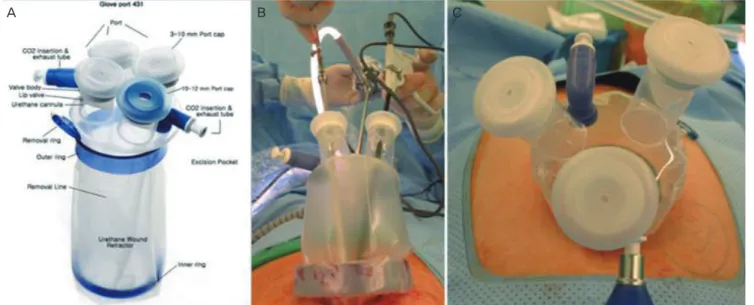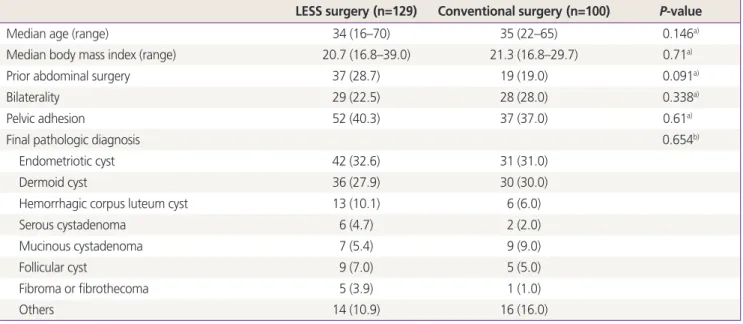http://dx.doi.org/10.5468/ogs.2014.57.5.386 pISSN 2287-8572 · eISSN 2287-8580
Introduction
The last four decades have witnessed a surgical shift from laparotomy to laparoscopy in gynecologic surgery [1]. Mini- mally invasive surgery has resulted in reduced morbidity rate, shorter hospital stays, and more rapid recovery, as reported in various studies. Technical innovations in instrumentation have not only affected simple procedures such as ectopic pregnancy management, but also highly complicated operations, includ- ing radical cancer [2-4].
Initially, laparoscopy in gynecologic surgery was performed with a single incision. However, due to technical limitations and increasingly complex surgeries, the use of additional inci- sions has become necessary. Recently, efforts have been made to reduce the number of laparoscopic ports the ultimate goal
being the absence of any visible scar [5]. Rapid advances in the development of laparoscopic instruments have allowed the ad-
A comparison of clinical and surgical outcomes between laparo-endoscopic single-site surgery and traditional multiport laparoscopic surgery for adnexal tumors
In Ok Lee, Jung Won Yoon, Dawn Chung, Ga Won Yim, Eun Ji Nam, Sunghoon Kim, Sang Wun Kim, Young Tae Kim
Department of Obstetrics and Gynecology, Institute of Women’s Medical Life Science, Yonsei University College of Medicine, Seoul, Korea
Objective
The purpose of this study was to compare clinical and surgical outcomes between laparo-endoscopic single-site (LESS) surgery and traditional multiport laparoscopic (TML) surgery for treatment of adnexal tumors.
Methods
Medical records were reviewed for patients undergoing surgery for benign adnexal tumors between January 2008 and April 2012 at our institution. All procedures were performed by the same surgeon. Clinical and surgical outcomes for patients undergoing LESS surgery using Glove port were compared with those patients undergoing TML surgery.
Results
A review of 129 patient cases undergoing LESS surgery using Glove port and 100 patient cases undergoing TML surgery revealed no significant differences in the baseline characteristics of the two groups. The median operative time was shorter in the LESS group using Glove port at 44 minutes (range, 19–126 minutes) than the TML group at 49 minutes (range, 20–196 minutes) (P=0.0007). There were no significant differences between in the duration of postoperative hospital stay, change in hemoglobin levels, pain score or the rate of complications between the LESS and TML groups.
Conclusion
LESS surgery showed comparable clinical and surgical outcomes to TML surgery, and required less operative time.
Future prospective trials are warranted to further define the benefits of LESS surgery for adnexal tumor treatment.
Keywords: Adnexal tumor; Glove port; Laparo-endoscopic single-site surgery; Laparoscopy; Port system
Received: 2014.1.22. Revised: 2014.3.5. Accepted: 2014.3.25.
Corresponding author: Young Tae Kim
Division of Gynecologic Oncology, Department of Obstetrics and Gynecology, Institute of Women’s Medical Life Science, Yonsei University College of Medicine, 50 Yonsei-ro, Seodaemun-gu, Seoul 120-749, Korea
Tel: +82-2-2228-2230 Fax: +82-2-313-8357 E-mail: ytkchoi@yuhs.ac
Articles published in Obstet Gynecol Sci are open-access, distributed under the terms of the Creative Commons Attribution Non-Commercial License (http://creativecommons.
org/licenses/by-nc/3.0/) which permits unrestricted non-commercial use, distribution, and reproduction in any medium, provided the original work is properly cited.
Copyright © 2014 Korean Society of Obstetrics and Gynecology
vancement of even less invasive procedures. Laparo-endoscop- ic single-site (LESS) surgery involves the use of one small skin incision to complete laparoscopic surgical procedures, which would have previously required multiple incisions [1].
To facilitate LESS surgery, the development of a port system, which allows several instruments to enter into the abdominal cavity in a single incision, was crucial. Glove port (Nelis, Seoul, Korea) is a newly developed system consisting of three or four channels within a single port. A single 20-mm to 25-mm inci- sion is needed to introduce the port system into the abdomi- nal cavity. The elastic caps in the channels of the port system allow the use of instruments from 3 to 15 mm in diameter.
Numerous studies have demonstrated the feasibility of LESS surgery using various port systems compared to that of tradi- tional multiport laparoscopic (TML) surgery [6-12]. However, these studies were limited by relatively small patient popula- tions, and few studies have evaluated the Glove port system.
Therefore, the aim of this study was to compare clinical and surgical outcomes between LESS surgery using Glove port system and TML surgery for adnexal tumors in a larger patient population.
Materials and methods
1. Patient and surgical characteristics
Medical records of patients undergoing surgery for benign adnexal tumors at our institution were reviewed. TML surgery
was the procedure of choice between January 2008 and De- cember 2009. From May 2010 to April 2012, surgeries were performed using the LESS surgery using the Glove port meth- od. All procedures were performed by a single surgeon at the Department of Obstetrics and Gynecology, Severance Hos- pital, Yonsei University College of Medicine in Seoul, Korea.
Glove port was adopted to LESS surgery in beginning of 2010 for some benign adnexal tumor surgeries. From May 2010 to April 2012, we had performed LESS surgery with Glove port system for every benign adnexal tumor surgery. Age, body mass index (mg/kg
2), and prior history of abdominal surgery were reviewed. Moreover, perioperative data, bilaterality of adnexal lesions, presence of pelvic adhesions, operative time, and types of procedures performed were analyzed. The pres- ence of pelvic adhesions was assessed by the surgeon at the time of the procedure. Operative time was defined as the interval between the initial incision to closure. The lengths of hospital stay, preoperative and postoperative hemoglobin lev- els, postoperative pain scores, and postoperative complication rates were also collected. Hemoglobin levels were measured sequentially for each patient preoperatively, and one and three days postoperatively. Pain was assessed in all patients using a validated visual analogue pain scale, scored from 0-10 (with
“0” representing “no pain” and “10” representing “agoniz- ing pain”) by a physician. Postoperative complications were defined as any surgery-related symptoms that patients com- plained of 4 weeks postoperatively. Final pathologic diagnoses were also compared.
Fig. 1. (A) A 4-channel model of Glove port. (B,C) Glove port demonstrated in the operation.
A B C
2. Techniques
All operations, including TML surgery and LESS surgery, were performed by one surgeon. In TML surgery, a 10-mm vertical intraumbilical incision was made, and a 10-mm trocar was in- serted bluntly. After creating a CO
2pneumoperitoneum, a rig- id 30°, 10-mm laparoscope was introduced into the abdomen through the trocar. Additional ancillary 5-mm trocars were placed at McBurney’s point, the counter-McBurney point, and 5 cm above the counter-McBurney point for insertion of conventional laparoscopic instruments. Organs were removed with the Endopouch retriever (Ethicon Endo-Surgery, Johnson
& Johnson Korea, Seoul, Korea) through the umbilicus.
In LESS surgery using Glove port system, a single 20- to 25-mm sized vertical incision was made in the navel area for Glove port system (Fig. 1). Glove port utilizes a manual retractor used in laparoscopy, which can be adjusted to the thickness of the port system. Three to four channels with the elastic gel-caps in the Glove port permit the introduction of instruments 3 to 15 mm in diameter into the abdominal cav- ity without CO
2gas leakage. Additional two valves allow CO
2gas in and out separately. A cord attached to the inner ring of the port system allows quick and easy removal of the Glove port. After the CO
2penumoperitoneum is created, a rigid 30°, 5-mm laparoscope was introduced through one of the chan- nels. Simultaneously, conventional laparoscopic instruments
were introduced through the remaining channels, as needed for the surgery.
3. Statistical methods
Data were analyzed using parametric and nonparametric sta- tistics, with the SPSS ver. 18.0 (SPSS Inc., Chicago, IL, USA).
Descriptive statistics were used for patient characteristic data, and the results are summarized as means and standard devia- tions. Continuous variables were examined for a normal distri- bution (Kolmogorov-Smirnov test) before adopting parametric statistics. Generally, for all analyses P<0.05 was considered significant.
Results
A total of 229 patients were included in this study; 129 in the LESS surgery group and 100 in the TML surgery group. None of the patients required laparotomy, and in the LESS group, no patients required an additional port during the operation.
The most common surgical indications, based on pathologic diagnoses, were endometriotic cyst and dermoid cyst in both groups respectively (Table 1). Patient characteristics, includ- ing age, BMI, prior abdominal surgery, bilaterality of lesions, pelvic adhesions, and final pathological diagnoses, were not
Table 1. Patient clinical characteristics
LESS surgery (n=129) Conventional surgery (n=100) P-value
Median age (range) 34 (16–70) 35 (22–65) 0.146a)
Median body mass index (range) 20.7 (16.8–39.0) 21.3 (16.8–29.7) 0.71a)
Prior abdominal surgery 37 (28.7) 19 (19.0) 0.091a)
Bilaterality 29 (22.5) 28 (28.0) 0.338a)
Pelvic adhesion 52 (40.3) 37 (37.0) 0.61a)
Final pathologic diagnosis 0.654b)
Endometriotic cyst 42 (32.6) 31 (31.0)
Dermoid cyst 36 (27.9) 30 (30.0)
Hemorrhagic corpus luteum cyst 13 (10.1) 6 (6.0)
Serous cystadenoma 6 (4.7) 2 (2.0)
Mucinous cystadenoma 7 (5.4) 9 (9.0)
Follicular cyst 9 (7.0) 5 (5.0)
Fibroma or fibrothecoma 5 (3.9) 1 (1.0)
Others 14 (10.9) 16 (16.0)
Values are presented as number (%) unless otherwise indicated.
LESS, laparo-endoscopic single-site.
a)The Student t-test was used for comparison; b)The x2 test was used for comparison.
significantly different between the two groups (Table 1). The types of procedures performed were not significantly different between the two groups (Table 2).
Surgical outcomes are listed in Table 3. The median opera- tive time was shorter in the LESS group at 44 minutes (range, 19–26 minutes) than in the TML group at 49 minutes (range, 20–196 minutes). This difference was statistically significant (P=0.0007). The median postoperative hospital stay was ap- proximately 2 days for both groups. The median hemoglobin level changes were nearly the same in both groups (postop- erative day 1, 1.9 g/dL [range, 0.1–5.0 g/dL] vs. 1.9 g/dL [range, 0.1–5.4 g/dL] P=0.703; postoperative day 3, 2.2 g/dL [range,
-0.1–6.9 g/dL] vs. 2.1 g/dL [range, -0.1–3.5 g/dL], P=0.292).
There were no significant differences postoperative pain score between the two groups.
Postoperative complications in the LESS group included five patients with difficulty voiding, eight patients with bowel dis- tention and irritation, four patients with wound dehiscence and one patient with an abdominal wall hematoma near the incision site. In the TML group, one patient complained of dif- ficulty voiding, two patients complained of bowel distention, and two patients developed abdominal wall hematoma. The incidence of these postoperative complications was equally distributed in both groups as illustrated in Table 4.
Table 2. Types of operations
LESS surgery Conventional surgery P-value
Ovarian cystectomy/enucleation 98 65
Oophorectomy 29 33
Salpingectomy 1 0
Others 1 2
x² test 0.197
LESS, laparo-endoscopic single-site.
Table 4. Postoperative complications
Complications LESS surgery Conventional surgery P-value
Voiding difficulty 5 1 0.235
Bowel distention/irritation 8 2 0.192
Wound dehiscence/infection 4 0 0.134
Abdominal wall hematoma 1 2 0.582
LESS, laparo-endoscopic single-site.
Table 3. Surgical outcomes
LESS surgery Conventional surgery P-value
Median operation time (min) 44 (19–126) 49 (20–196) 0.007
Median hospitalization days after operation (day) 2 (2–9) 2 (1–12) 0.163
Median Hb down (g/dL)
PO day 1 1.9 (0.1–5.0) 1.9 (0.1–5.4) 0.703
PO day 3 2.2 (-0.1–6.9) 2.1 (-0.1–3.5) 0.292
Median pain score
PO 6 hr 4 (2–7) 4 (1–7) 0.779
PO 24 hr 3 (1–5) 2 (1–5) 0.305
PO 48 hr 2 (0–4) 2 (0–5) 0.855
Values are presented as number (range).
LESS, laparo-endoscopic single-site; PO, postoperative.


